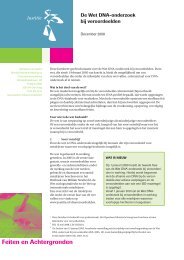INTERPOL HANDBOOK ON DNA DATA EXCHANGE AND PRACTICE
INTERPOL HANDBOOK ON DNA DATA EXCHANGE AND PRACTICE
INTERPOL HANDBOOK ON DNA DATA EXCHANGE AND PRACTICE
Create successful ePaper yourself
Turn your PDF publications into a flip-book with our unique Google optimized e-Paper software.
If at any time during the sampling process, the sample taken is dropped or comes intocontact with any other surface the procedure should be stopped and the sampling kitdisposed of. The samples should then be taken using a new <strong>DNA</strong> sampling kit.Once the samples have been successfully taken, the wrappers and gloves should becollected and disposed of using designated receptacles.As part of the collection procedure, the details of the donor and other necessaryinformation should be noted on the form provided. The form and the samples shouldthen be placed in the tamper evident container, stored appropriately and sent to thelaboratory as per legal instructions.This procedure should also be applied to obtain samples from persons associated withthe offence, or the victim, or the crime scene. For example, in the case of sexual assault,it may be necessary to obtain reference samples from consensual sexual partners ofthe victim to assist in identifying any <strong>DNA</strong> that has originated from the perpetrator.Other examples include the owner of a car that has been stolen or the usual inhabitantsof an area that has become a crime scene.•anti-contamination guidelines• Due to the sensitivity of current <strong>DNA</strong> techniques, extreme caution, including wearinga face mask, must be taken if the person undertaking the crime stain sampling hasa medical condition that causes the shedding of body fluids or particles e.g. colds,coughs or influenza. Other conditions such as eczema or severe dandruff may requirethe wearing of additional barrier clothing.• All containers used for transportation (e.g. cool boxes, crates, boxes) should becleaned before and after use, or, if possible, not re-used.• Scene of crime officers’ work area should be cleaned regularly with wipes containingchlorohexadine.• Wherever possible <strong>DNA</strong>-free, disposable sampling materials should be used.• Disposable gloves must always be worn over cuffs and should be changed after handlingindividual items/objects. Barrier clothing should also be used as often as possible.• For serious offences wear disposable face masks, overshoes and hooded suits.• Handle items as little as possible, items should not be re-opened even for interviewpurposes. Use paper bags with transparent panels.• Always handle one item at a time.• It may be necessary to change gloves between the handling of different items.• Where possible, take the container to the evidence and not the evidence to thecontainer.• Contact between victim and suspect samples should be avoided at all times.• Ensure that any person attending a crime scene has no contact with a suspect or his/her clothing.• Multiple suspects, the victim and their clothing must be kept apart at all times andshould not be allowed to come into contact with the same objects (e.g. police car,interview room, custody suite).<strong>DNA</strong> SAMPLING<strong>AND</strong> EVIDENCE COLLECTI<strong>ON</strong>PAGE 27







